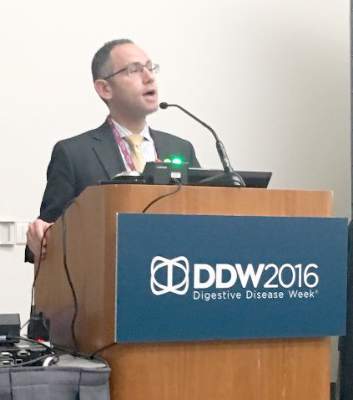AT DDW 2016
SAN DIEGO (FRONTLINE MEDICAL NEWS) – A disposable Endocuff cut colonoscopic withdrawal times by nearly a minute and slightly improved polyp detection, compared with standard colonoscopy, according to a randomized, prospective trial of 562 patients.
The Endocuff caused no known adverse effects except for superficial mucosal trauma, Dr. Paul Feuerstadt said at the annual Digestive Disease Week. The study, which is the first of its kind in the United States, suggests that the Endocuff can improve the efficiency of colonoscopies without undermining detection rates, he added.
The plastic, flexible Endocuff slides onto the tip of a standard colonoscope, and has phalanges that press on the colonic mucosa “to improve polyp and adenoma detection rates, at least in theory,” said Dr. Feuerstadt , who is at the Gastroenterology Center of Connecticut in Hamden, Conn.
Use of the device improved the polyp detection rate by 63% and adenoma detection by 86% in a previous study in Germany.
For the current study, Dr. Feuerstadt and his associates screened 1,067 consecutive patients at two endoscopy centers in Connecticut, and excluded those with colitis, inflammatory bowel disease, diarrhea, chronic splenomegaly, and a history of surgical resection or colonic stricture. The 562 remaining patients were randomized to either Endocuff-assisted or standard colonoscopies performed by eight endoscopists with historically high adenoma detection rates of nearly 44%.
Use of the Endocuff seemed to slightly improve polyp detection, though none of the primary comparisons reached statistical significance, despite sufficient study power, Dr. Feuerstadt said. The rate of polyp detection was 63% for Endocuff-assisted colonoscopy and 60% for standard colonoscopy (P = .41), while rates of adenoma detection were 42% and 45%, respectively. There was a nonsignificant trend toward higher detection of sessile serrated adenomas (11% versus 9%; P = .37).
Notably, average withdrawal times were 9.9 minutes with the Endocuff (standard deviation, 5.5 minutes), versus 11.1 minutes without it (standard deviation, 5.9 minutes; P = .02). There were no perforations or other major adverse events, no instances of the Endocuff coming off the scope, and no difference in bleeding rates between the two groups.
However, 8% of Endocuff patients had mild mucosal trauma, compared with none of the control group, Dr. Feuerstadt reported.
The two groups resembled one another demographically, clinically, and in terms of their family history of colonic polyps. However, the Endocuff group had a higher frequency of first-degree relatives younger than age 50 years with colon cancer, Dr. Feuerstadt noted.
The endoscopists had an average historical ADR of 43.6%, “very similar to the 44.7% we saw in the study,” he added. “The device yields similar adenoma detection rates overall, with shorter withdrawal times, thereby increasing colonoscopic efficiency.”
Dr. Feuerstadt did not report funding sources. He disclosed consulting fees from Medivators, which makes endoscope reprocessing and related products.
ginews@gastro.org






